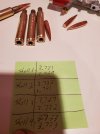CBH Australia
Well-Known Member
are you meaning Bushing dies? Or the Lee Collet dies?I have only encountered neck collars (donuts) when extreme forming/re-sizing, or once on many reloads of same few cases. Our solution was align-boring to .005 over bullet diameter. We now carefully re-size neck with collet dies!
I have considered trying bushing dies.
My rifles and loads are acceptable for hunting but it's just a learning curve and I would like to get the best out of it. If I have a hunting load at say .5 or better it's just going to be a little more accurate as the distance increases.
I've always said an accurate rifle will compensate a little for a little human, technique or ability , error or external effects on the shot.
Plus I just want to head out with the confidence of having a .5moa rifle and have the bragging rights.
I've spent more on this rifle and associated components than others I would like to see something in return.

